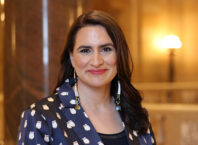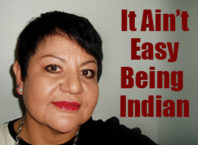Fond du Lac Follies jetted to Washington D and C. I went to sign copies of my new book, Rez Salute, in the store at the National Museum of the American Indian. I also agreed to give a talk there about my seasonal life as an Anishinaabe living on the Rez. I also hoped to take part in the reading of the apology at the Capital Reflecting Pool.
I padded through the Security Check point at the Minneapolis airport and got redressed on the other side. I had removed my jacket, belt and shoes, had also emptied my pockets. The TSA people, the ones with the blue shirts, gold badges and purple gloves agreed I didn’t look like a terrorist and let me proceed to the waiting area for the flight. I shoehorned in with the other passengers and had an uneventful flight to Reagan National Airport. I like my flights to be uneventful.
Publicist Liz Hill, a Red Lake skin, met me in the baggage claim area and escorted me to her car.
We slipped through the traffic and arrived at the beautiful building that houses the National Museum of the American Indian. I had earlier sent Liz 35 photographs for each of the three activities. I introduced myself in Ojibwe and began talking about how we make maple syrup in my family. I showed details of how I carve taps, how I build my firepit, and stack the firewood around the kettle. I also explained the signs I watch for so I know when to tap the trees. In the photographs I showed how the sun melted a circle at the base of the trees.
I then moved on to summer and showed pictures of how we peel birch bark from the trees, how we gather basswood bark for the sewing and green willow for the frames of the fanning baskets we make, in Ojibwe nooshkachinaaganike. The photographs helped people visualize how the baskets came together. Liz brought her basket so people could examine a real noooshkachinaagan.
Finally I talked about Manoominike, making rice. The photographs showed people out in the lake knocking rice, also showed Shinnobs stopping for a break with other ricers. The photographs showed the people at the landing and sacking up the manoomin. I explained how we put the rice out in the sun to dry for a couple of hours before we begin parching. The photographs showed young children learning how to parch the rice without burning it. There were photographs of people dancing on the rice and using the fanning baskets to fan the rice to separate the hulls from the grain. There was even a picture of a young woman using a tweezers to pick the brown hulls out of the green rice.
After the talk I went downstairs to the Museum store and signed books. Jay Winter Nightwolf was there to help me bring in the customers. Jay has a radio show in D and C and I have been a guest on his show a couple of times now. He bought several books to give to his friends.
**** The next day Indians and friends began gathering at the Capital Reflecting pool to read the apology America offered to American Indians. It was a secret apology because it was buried in the middle of a Defense Department appropriations Bill.
Mark Charles, a Navajo from New Mexico, wanted to make the apology less of a secret and to let the United States know the apology wasn’t accepted. For more information please see: www.wirelesshogan.com.
While I was waiting for my turn to talk I met painter Elmer Yazzie of Arizona. He made a large painting of his reaction to the apology.
Rick Gresczyk, helped me translate the apology into Ojibwemowin. I then said the words when it was my turn at the microphone. First I introduced myself in Ojibwe then translated the words into English. I then read what we understood about the US apology. I did not translate those words.
When I was done speaking Ojibwemowin I thanked the people for listening to me and stepped away from the microphone.
My friend Ted Charles and I ate a meal then went to the Wall, the Vietnam Veterans Memorial. We were young Marines together many decades ago. Ted is proud of his son Mark Charles who organized the gathering about the apology.
The next morning I flew to Chicago to change planes. My connecting flight was cancelled and I became a leper and joined the people on the standby list. No one on the list got out of Chicago that day, the next day a morning flight carried me back to Minnesota. Ray Earley was standing by to drive me north. I am home again.





